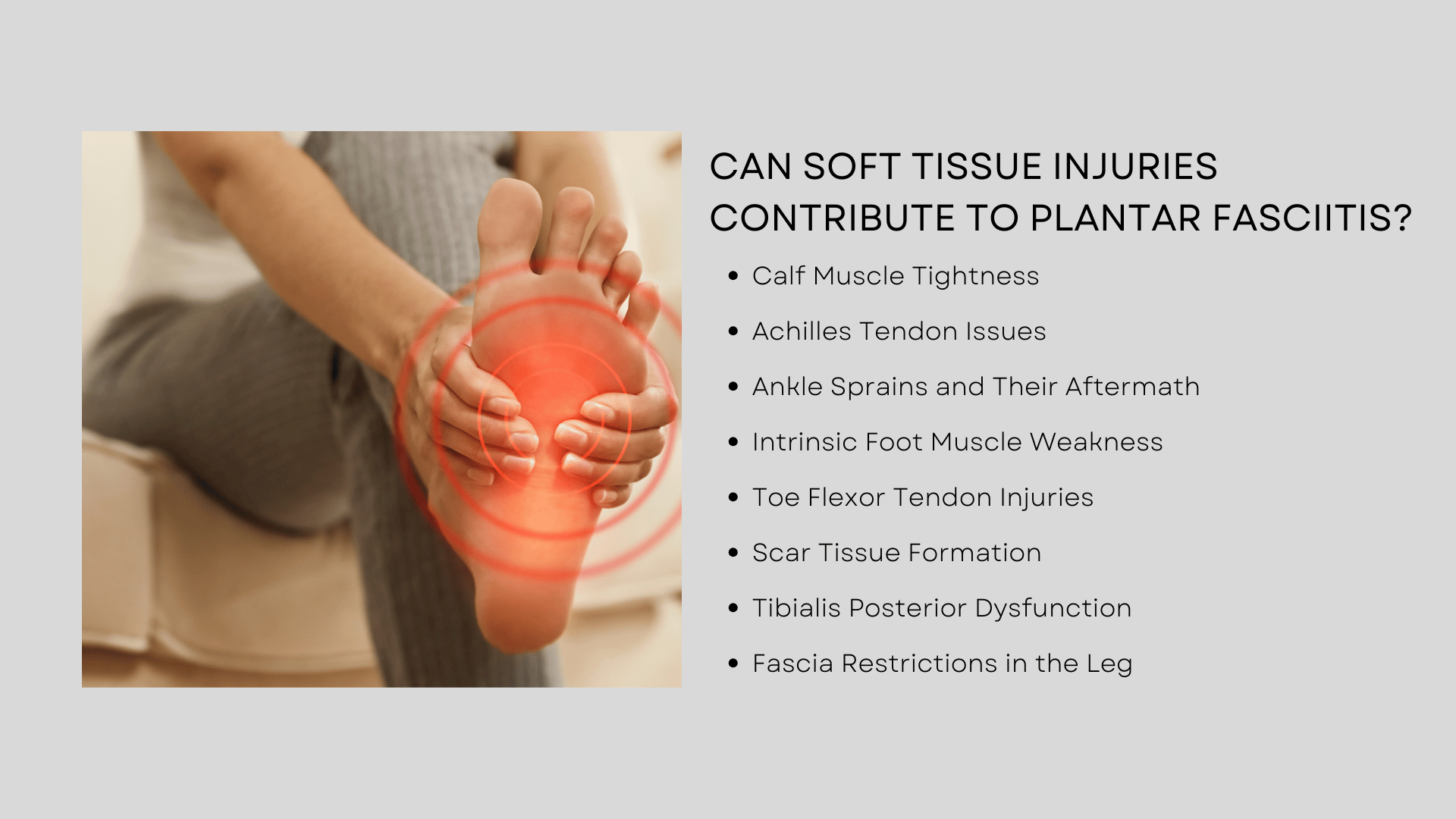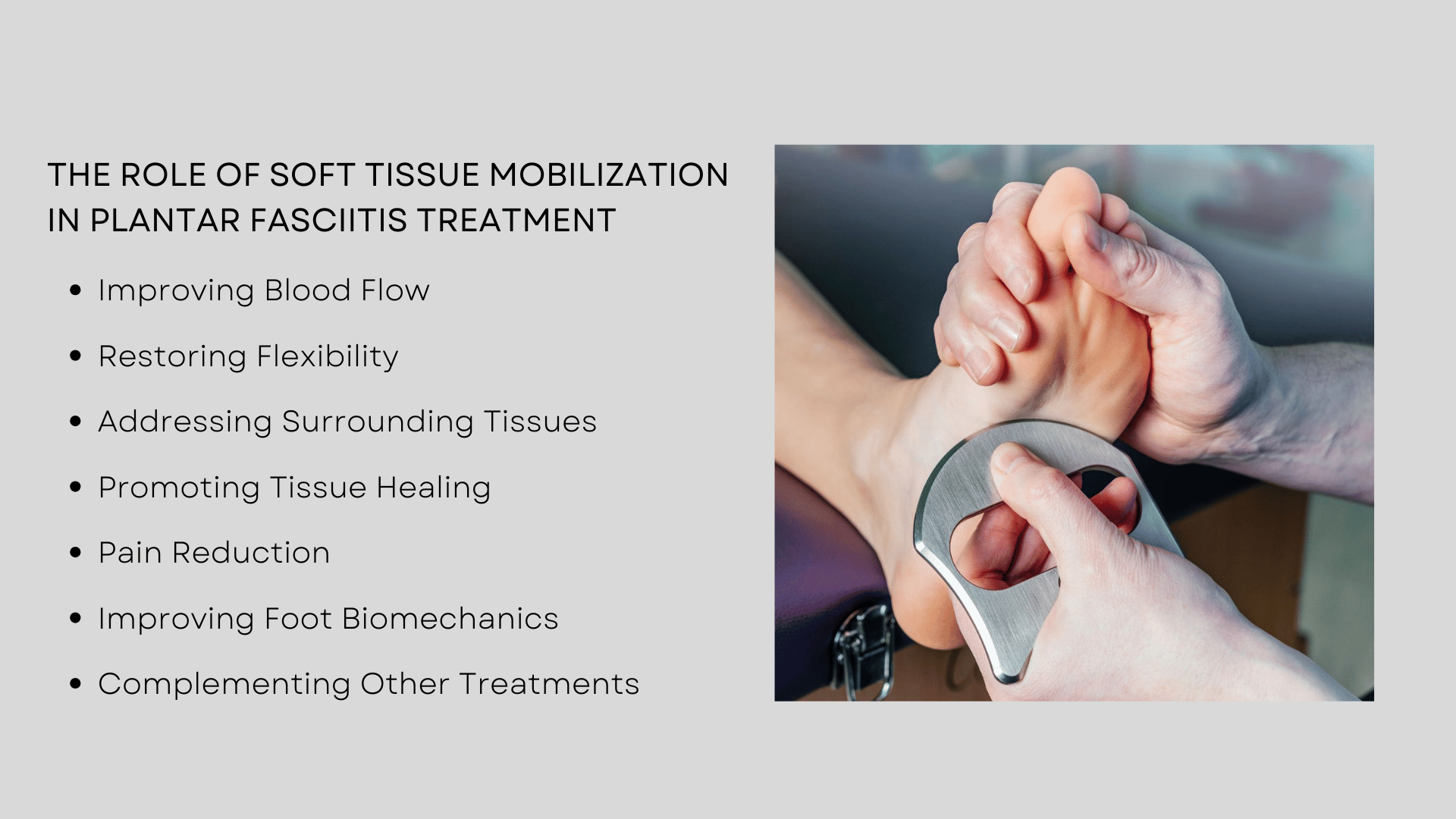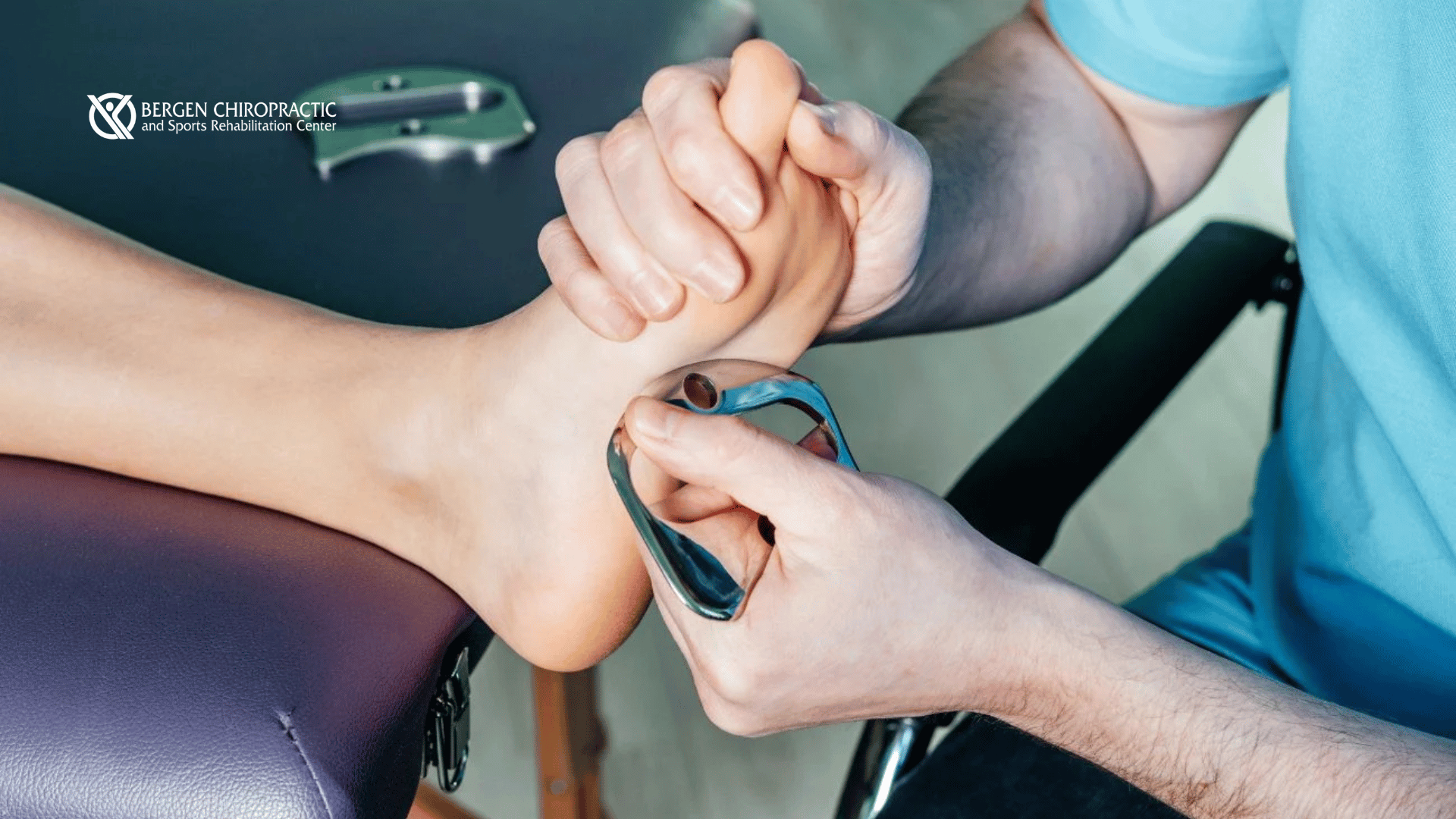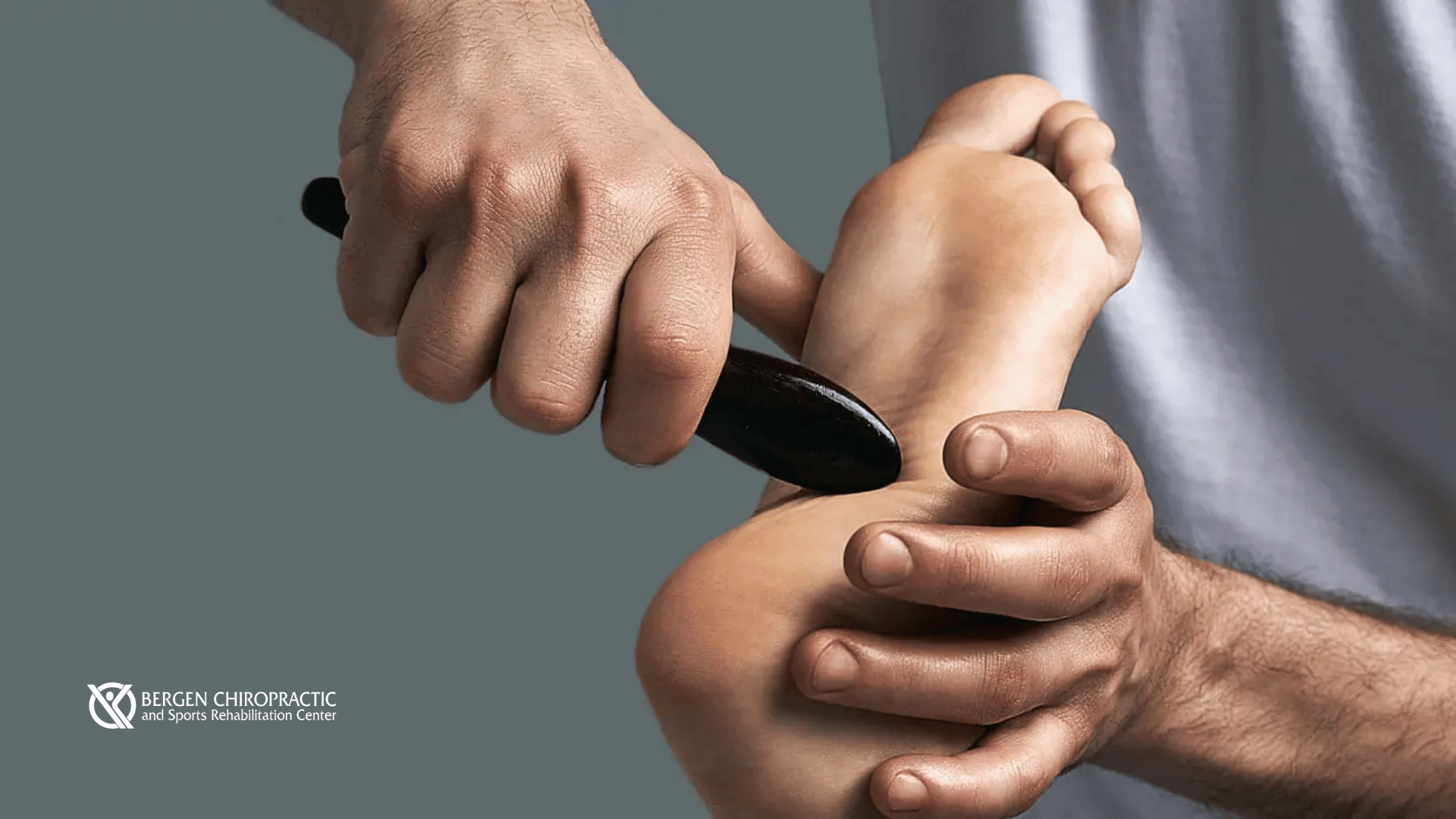Are you sick of waking up to that pesky foot and heel pain every morning? You’re not alone—plantar fasciitis can be a real pain, especially for those who love to stay active.
But here’s some good news: chiropractic soft tissue techniques could be just what you need to find relief. Our hands-on, gentle methods can help ease your pain and get you back to doing what you love pain-free!
Can Soft Tissue Injuries Contribute to Plantar Fasciitis?

Soft tissue injuries in your feet, ankles, and even up into your calves can play a sneaky role in developing chronic plantar fasciitis. It’s like a complex web of interconnected parts, where an issue in one area can trigger problems elsewhere.
- Calf Muscle Tightness: Tight calf muscles (gastrocnemius and soleus) can limit ankle dorsiflexion. This limitation forces your foot to compensate during walking or running. The extra stress on the plantar fascia can lead to inflammation and pain.
- Achilles Tendon Issues: The Achilles tendon connects your calf muscles to your heel bone. Tendonitis or tightness in this area can alter your foot mechanics. This change can increase tension on the plantar fascia, potentially leading to plantar fasciitis.
- Ankle Sprains and Their Aftermath: A history of ankle sprains can lead to chronic ankle instability. This instability can change how you distribute weight across your foot. Uneven weight distribution can overload certain parts of the plantar fascia.
- Intrinsic Foot Muscle Weakness: The small muscles in your foot play a crucial role in supporting your arch. Weakness in these muscles can lead to excessive flattening of the arch during activity, which puts additional strain on the plantar fascia.
- Toe Flexor Tendon Injuries: Injuries to the tendons that flex your toes can alter your gait and change how stress is distributed across your foot. The plantar fascia may end up bearing more load than it’s designed to handle.
- Scar Tissue Formation: Previous injuries can lead to the formation of scar tissue in the foot or ankle. Scar tissue is less flexible than normal tissue and can restrict movement. These restrictions can force the plantar fascia to compensate, leading to overuse.
- Tibialis Posterior Dysfunction: The tibialis posterior muscle helps support your arch. If this muscle is injured or weakened, it can lead to overpronation. Overpronation is a known risk factor for plantar fasciitis.
- Fascia Restrictions in the Leg: The fascia in your leg is connected to the fascia in your foot. Restrictions in the leg fascia can pull on the plantar fascia. This constant pulling can irritate the plantar fascia over time.
The Role of Soft Tissue Mobilization in Plantar Fasciitis Treatment

When treating plantar fasciitis, soft tissue mobilization is like a magic wand for your feet. This technique goes beyond just addressing surface-level symptoms, targeting the root causes of your discomfort.
Over time, the plantar fascia can develop adhesions or “sticky” areas where tissues are bound together. Soft tissue mobilization uses targeted pressure and movement to break up these adhesions. This process helps restore normal tissue mobility and reduces pain.
Improving Blood Flow:
- The technique stimulates circulation in the affected area.
- Increased blood flow brings more oxygen and nutrients to the tissues.
- Better circulation also helps remove waste products and inflammatory substances.
Restoring Flexibility:
- Plantar fasciitis often leads to tightness in the fascia and surrounding muscles.
- Soft tissue mobilization helps lengthen and relax these tight tissues.
- Improved flexibility can reduce strain on the plantar fascia during movement.
Addressing Surrounding Tissues:
- The technique also targets calf muscles, Achilles tendon, and other foot muscles.
- Soft tissue mobilization can also help break down scar tissues, improve muscle and joint function and flexibility, and reduce inflammation.
- This comprehensive approach helps balance the entire kinetic chain of the lower leg.
Promoting Tissue Healing:
- The controlled microtrauma caused by soft tissue mobilization can stimulate the body’s healing response.
- This can lead to the production of new, healthier tissue fibers.
Pain Reduction:
- By addressing the underlying tissue restrictions, soft tissue mobilization can significantly reduce pain.
- Many patients report immediate relief following treatment.
Improving Foot Biomechanics:
- As tissues become more pliable, overall foot function often improves.
- This can lead to better weight distribution and reduced stress on the plantar fascia.
Complementing Other Treatments:
- Soft tissue mobilization works well with other therapies like stretching exercises, shoes, and orthotics.
- It can enhance the effectiveness of these other treatments by preparing the tissues for change.
Chiropractic Soft Tissue Techniques for the Foot

Our chiropractors have a diverse toolbox of soft tissue techniques to help your feet feel fantastic. Each method has a unique approach, but they all share the goal of improving tissue health and mobility.
Myofascial release focuses on the fascia, the connective tissue surrounding muscles and organs. Our chiropractors apply gentle, sustained pressure to the fascia. This pressure helps to elongate the fascia and break up adhesions. For plantar fasciitis, it can be particularly effective in releasing tension in the plantar fascia itself.
Patients often report a sensation of the tissue “melting” or releasing during treatment. Additionally, this technique can be beneficial for addressing chronic muscular pain by relieving tightness and tension in the affected areas, leading to improved mobility and reduced pain.
Trigger points are hyperirritable spots in the muscle or fascia that can cause pain.
In plantar fasciitis, trigger points in the foot or calf muscles can contribute to heel pain. Our chiropractors apply direct pressure to these points to release tension. This helps alleviate pain in the foot and related areas like the calf or lower back.
It’s important to distinguish between heel spurs and plantar fasciitis, as heel spurs are bony outgrowths resulting from stress on the plantar fascia and typically do not cause pain, whereas plantar fasciitis is a more prevalent cause of heel discomfort. Patients might feel a temporary increase in discomfort followed by significant relief.
Active Release Technique (ART) is a patented, movement-based massage technique. It combines precisely directed tension with specific patient movements. For plantar fasciitis, our chiropractors might apply pressure to the plantar fascia while you flex and extend your foot. This technique is particularly effective for breaking up scar tissue and adhesions. It can help improve the range of motion and reduce pain relatively quickly.
The Graston Technique is a form of instrument-assisted soft tissue mobilization. Our chiropractors use specially designed stainless steel instruments to detect and treat areas of scar tissue or restriction. For plantar fasciitis, these tools can help break up adhesions in the plantar fascia and surrounding tissues. The technique can stimulate blood flow and promote healing.
Each technique has its strengths, and your chiropractor might use one or a combination, depending on your specific condition.

Ready for Happy, Pain-Free Feet? Book Your Soft Tissue Mobilization Treatment Today!
Don’t let plantar fasciitis keep you sidelined any longer. At Bergen Chiropractic, we’re ready to put our soft tissue techniques to work for you. Whether you’re dealing with chronic heel pain or you’re just starting to feel that telltale ache, we’ve got the tools and expertise to help. Ready to take the first step towards pain-free feet?
Access our contact form or call us at (201) 357-6539 to learn more about our chiropractic care services! Our offices at 532 Anderson Avenue, Cliffside Park, NJ 07010, and 62 Summit Ave, Hackensack, NJ 07601, are ready to welcome you as we proudly serve the areas of New York, New Jersey, Philadelphia, PA, and Baltimore, MD. Also, access our blog, Facebook, and Instagram pages for more information on chiropractic care for plantar fasciitis!








